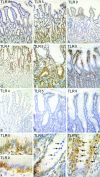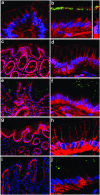Expression and subcellular distribution of toll-like receptors TLR4, TLR5 and TLR9 on the gastric epithelium in Helicobacter pylori infection
- PMID: 15147355
- PMCID: PMC1809056
- DOI: 10.1111/j.1365-2249.2004.02464.x
Expression and subcellular distribution of toll-like receptors TLR4, TLR5 and TLR9 on the gastric epithelium in Helicobacter pylori infection
Abstract
Toll-like receptors (TLRs) expressed by mucosal epithelium play an essential role in the defense against microbes by recognizing conserved bacterial molecules. For the first time TLR4, TLR5 and TLR9 have been microanatomically localized in patients with noninflamed gastric mucosa and Helicobacter pylori gastritis by immunohistochemistry. Because polarized expression of TLRs in apical and basolateral epithelial compartments is thought to modulate mucosal immunity, subcellular TLR distribution by gastric epithelium was investigated using confocal microscopy. TLR4, TLR5 and TLR9 were expressed by gastric epithelium in antrum and corpus of all patients with H. pylori gastritis (n = 14) and with noninflamed gastric mucosa (n = 5). TLR4 was expressed at the apical and the basolateral pole of the gastric epithelium as well in noninflamed gastric mucosa as in H. pylori gastritis. TLR5 and TLR9 expression in the noninflamed gastric mucosa was identical to that of TLR4 with localization at the apical and the basolateral epithelial pole. However, in H. pylori gastritis TLR5 and TLR9 expression on the gastric epithelium changed to an exclusive basolateral localization without detectable expression at the apical pole. In the human stomach, the gastric epithelium expressed TLR4, TLR5 and TLR9, which gives it the possibility to interact with H. pylori. Furthermore, gastric epithelial TLR4 expression is highly polarized in an apical and a basolateral compartment, whereas TLR5 and TLR9 polarization seems to be a process dynamically influenced by H. pylori infection. This polarized and dynamically regulated gastric epithelial expression of TLRs supports a sentinel role for these receptors in the mucosal immunity to H. pylori.
Figures


Similar articles
-
DNA Transfer and Toll-like Receptor Modulation by Helicobacter pylori.Curr Top Microbiol Immunol. 2017;400:169-193. doi: 10.1007/978-3-319-50520-6_8. Curr Top Microbiol Immunol. 2017. PMID: 28124154 Free PMC article. Review.
-
Toll-like receptors TLR4, TLR5 and TLR9 on gastric carcinoma cells: an implication for interaction with Helicobacter pylori.Int J Med Microbiol. 2005 Jun;295(3):179-85. doi: 10.1016/j.ijmm.2005.02.009. Int J Med Microbiol. 2005. PMID: 16044857
-
Helicobacter pylori regulates TLR4 and TLR9 during gastric carcinogenesis.Int J Clin Exp Pathol. 2014 Sep 15;7(10):6950-5. eCollection 2014. Int J Clin Exp Pathol. 2014. PMID: 25400780 Free PMC article.
-
Toll-like receptor 9 signaling has anti-inflammatory effects on the early phase of Helicobacter pylori-induced gastritis.Biochem Biophys Res Commun. 2012 Sep 28;426(3):342-9. doi: 10.1016/j.bbrc.2012.08.080. Epub 2012 Aug 24. Biochem Biophys Res Commun. 2012. PMID: 22940550
-
Toll-like Receptor 4 Signaling Mediates Gastritis and Gastric Cancer.Curr Mol Med. 2025;25(4):388-398. doi: 10.2174/0115665240276139231206071742. Curr Mol Med. 2025. PMID: 38204278 Review.
Cited by
-
Ceramide and Toll-like receptor 4 are mobilized into membrane rafts in response to Helicobacter pylori infection in gastric epithelial cells.Infect Immun. 2012 May;80(5):1823-33. doi: 10.1128/IAI.05856-11. Epub 2012 Feb 21. Infect Immun. 2012. PMID: 22354030 Free PMC article.
-
Deficiencies of myeloid differentiation factor 88, Toll-like receptor 2 (TLR2), or TLR4 produce specific defects in macrophage cytokine secretion induced by Helicobacter pylori.Infect Immun. 2007 May;75(5):2408-14. doi: 10.1128/IAI.01794-06. Epub 2007 Mar 12. Infect Immun. 2007. PMID: 17353291 Free PMC article.
-
DNA Transfer and Toll-like Receptor Modulation by Helicobacter pylori.Curr Top Microbiol Immunol. 2017;400:169-193. doi: 10.1007/978-3-319-50520-6_8. Curr Top Microbiol Immunol. 2017. PMID: 28124154 Free PMC article. Review.
-
LPS induces translocation of TLR4 in amniotic epithelium.Placenta. 2007 May-Jun;28(5-6):477-81. doi: 10.1016/j.placenta.2006.08.004. Epub 2006 Oct 19. Placenta. 2007. PMID: 17055575 Free PMC article.
-
TLR9 and NF-κB are partially involved in activation of human neutrophils by Helicobacter pylori and its purified DNA.PLoS One. 2014 Jul 2;9(7):e101342. doi: 10.1371/journal.pone.0101342. eCollection 2014. PLoS One. 2014. PMID: 24987851 Free PMC article.
References
-
- Marshall BJ. Unidentified curved bacilli on gastric epithelium in active chronic gastritis. Lancet. 1983;4:1273–5. - PubMed
-
- Marshall BJ, Warren JR. Unidentified curved bacilli in the stomach of patients with gastritis and peptic ulceration. Lancet. 1984;16:1311–4. - PubMed
-
- Rauws EAJ, Langenberg W, Houthoff HJ, Zanen HC, Tytgat GNJ. Campylobacter pyloridis-associated chronic active antral gastritis. Gastroenterology. 1988;94:33–40. - PubMed
-
- Dixon MF. Helicobacter pylori and peptic ulceration: histopathological aspects. J Gastroenterol Hepatol. 1991;6:125–30. - PubMed
-
- Akira S, Takeda K, Kaisho T. Toll-like receptors: critical proteins linking innate and acquired immunity. Nat Immunol. 2001;2:675–80. - PubMed
Publication types
MeSH terms
Substances
LinkOut - more resources
Full Text Sources
Medical

